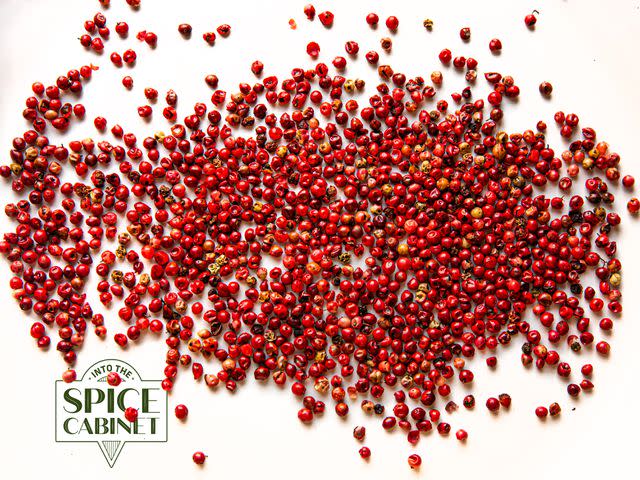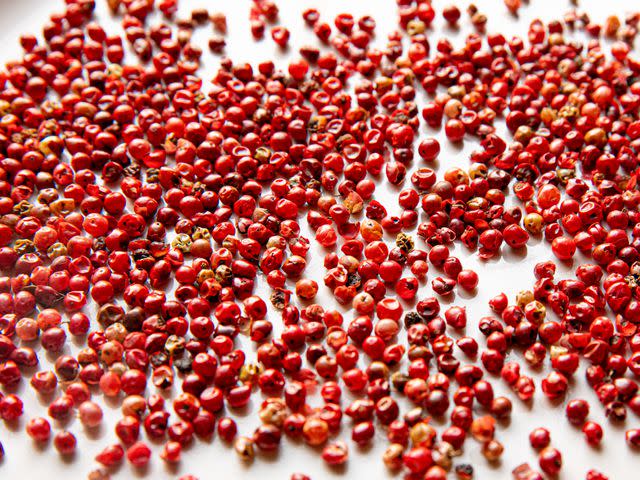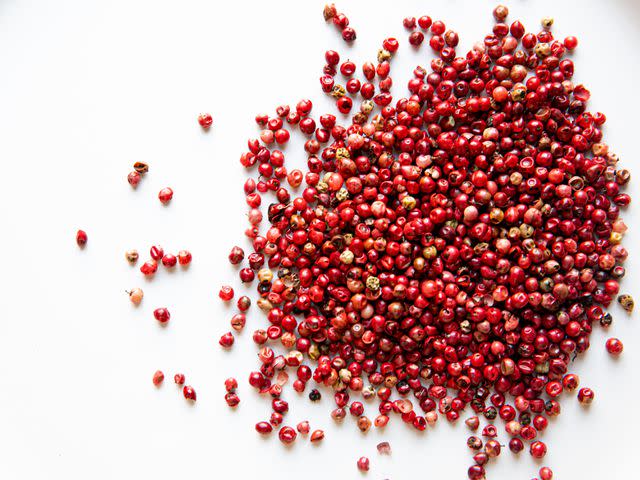What Are Pink Peppercorns?
Everything you need to know about the fruity, floral spice—including how to buy, store, and cook with it.
Pink Peppercorns
Description: Small, round seeds with a pinkish red hue from Peruvian (schinus molle) and Brazilian (schinus terebinthifolius) pepper trees
Flavor profile: Floral, fruity, peppery
Related cuisines: Thai, Mediterranean, French, South American
Storage: In a tightly sealed, non-porous jar, whole pink peppercorns will last about 18 months.
In a sea of black, white, and green peppercorns, pink peppercorns know how to stand out. I first took notice of the spice in a souk in Morocco, where its bright pink hue seemed to overshadow the many earthy-colored spices surrounding it. It laid in a large pile, the vibrant spheres nestled within each other. When I reached down to grab a handful and put it up to my nose, its sharp, peppery scent mixed with rosy notes enveloped my nostrils. I knew I had landed on something special, so I purchased a small amount to take home and give it a try.
It was only after discovering the spice myself that I learned it’s not actually a pepper, but instead a berry. It adds a bright, fruity, and floral note to anything it touches—once you get the hang of it, you’ll want to use it anywhere you can. We spoke with Claire Cheney—founder and self-proclaimed “Blender-in-Chief” of Curio Spice, a spice shop in Cambridge, Massachusetts—to learn more about how to take advantage of this vivid, flavorful spice, as well as where it comes from and how to shop for it.

Serious Eats / Amanda Suarez
What Are Pink Peppercorns?
Pink peppercorns aren’t actually related to the other varieties we’re more familiar with, which come from the Piper nigrum plant. Instead, they are the ripe berries of the Peruvian (schinus molle) and Brazilian (schinus terebinthifolius) pepper trees. The peppercorns belong to the Anacardiaceae family, along with cashews, pistachios, and mangoes. In the US, the berries are considered an invasive species, so much so that Cheney notes that since they thrive in coastal environments, you can even find them on the side of the road in Florida. They have even been referred to as “Florida holly.”
“[A pink peppercorn] just so happens to be the same general size as a black peppercorn, so it kind of got this misnomer,” says Cheney: “While it does have a little pepperiness to it, it doesn't have the compound called pipperine, which is what gives black, green, and white peppers their heat.”

Serious Eats / Amanda Suarez
While pink peppercorns are readily available at spice markets today, our senior culinary director, Daniel Gritzer, considers them to be more of a food (and a food trend) associated with the ‘80s and ‘90s. “It was a fad ingredient that caught fire for a while thanks to its visual pop, slightly floral, and only vaguely peppery flavor, and tropical exotic vibes,” he says. “But then I also remember my dad telling me that they might be poisonous, which was apparently a bit of late-20th-century #fakenews that spread thanks to a panicked media frenzy.” In the 1980s, two scientists discovered the plant was closely related to poison ivy, leading to an importation ban by the FDA in 1982. However, given their popularity in both French cuisine and agriculture, the island of Réunion, a French territory near Madagascar, harvested a number of peppercorns. They then used research to argue against the toxicity of the spice, and the FDA eventually reversed the ban. It is worth mentioning peppercorns are only known to be toxic in large quantities.
“The whole situation was similar to the freakout around the same time about MSG known as ‘Chinese Restaurant Syndrome,’” says Gritzer. “Clearly the attraction to foreign foods was balanced by an equally substantial (and irrational) fear of them. Pretty quickly after that, the pink peppercorn faded away, only to be found today in dated-looking tricolor peppercorn blends and bars of white chocolate.”
How to Buy and Store Pink Peppercorns
Though you may be able to find pink peppercorns at your local grocery store, you’re more likely to spot them in international markets. Due to their volatile oils, it’s rare to find ground pink peppercorns for sale. They are almost always sold whole and can be crushed or ground right before use.
“The structure of the seed itself is key,” says Cheney. “There's a ton of pink pepper on the market that’s very shriveled looking and not as tasty.” She advises looking for whole, perfect spheres with a deep pink or red color. Cheney notes that commodity level spices are often sundried, in turn destroying the structure of the berry and creating a wrinkled look with a bitter taste. Shade-dried pink peppercorns, on the other hand, will preserve the sphere and keep the volatile oils in tact, which further preserves the berry’s delicate flavor.
High-quality whole peppercorns can last as long as 18 months if stored in a tightly sealed, non-porous jar that’s left in a cool, dark, and dry place.
How to Cook With Pink Peppercorns
The floral and fruity flavor of pink peppercorns works well in spice rubs for meat, poultry, and fish since it can uplift any heavy, rich notes. That fruitiness also accompanies ingredients like galangal, garlic, and lemongrass quite well, making it a great addition to many Thai curries. Since its color can add vibrancy to many dishes, Cheney recommends using it as a garnish or a last step so the color doesn’t fade when cooking; however, its fruity, floral notes will still come through after being cooked.

Serious Eats / Amanda Suarez
The spice pairs nicely with other spices like coriander, sesame, cinnamon, and mint. They do also go well with other peppercorns, and you’ll often find them dotted throughout peppercorn blend grinders. Given the delicacy of the spice, when using it on its own it’s best to crush the peppercorns with a knife or a spice grinder instead of a pepper mill.
Cheney likes to use pink peppercorns whole or crushed to garnish salads and ceviche, adding that you can use the spice quite generously compared to actual peppercorns. And when it comes to unconventional uses, she notes that it also goes well in lemony cocktails. “You can make a simple syrup out of it, she says, “and it provides a really beautiful color and flavor for gin cocktails.”
Read the original article on Serious Eats.

